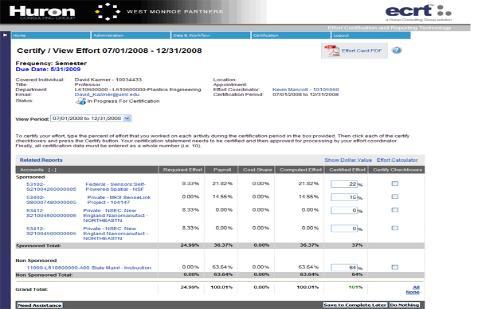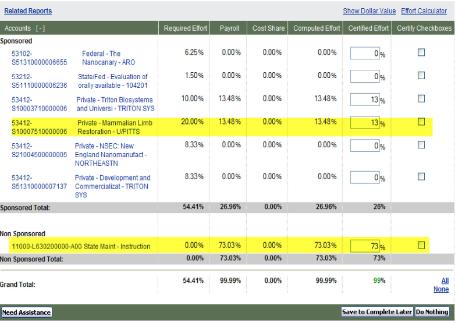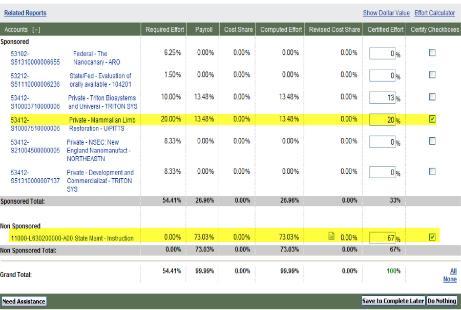5. Effort certification guildlines
The effort statement
The image below shows an ECC effort statement.

The top part of the effort statement shows administrative detail including the name of your Effort Coordinator. Please note that sponsored project financial administrators have also received ECC training and can be used as a resource for questions.
The next part of the effort statement shows information about sponsored projects. Each line represents a project from which you were paid, or a project to which you might have devoted cost-shared effort.
On the bottom half of your statement, your non-sponsored activities are shown.
Reading across the statement, the six columns are:
Column name and what it means:
- Accounts - For sponsored activity, the fund, project account, abbreviated title and sponsor name is shown. For non-sponsored activity, the fund, account number and title are shown.
- Required Effort - The commitment of Effort reflected in the final accepted budget and made a part of the award. This field is automatically populated through the PeopleSoft grants module.
- Payroll- Payroll distribution for the certification period. This field is automatically populated through the PeopleSoft financial system
- Cost Share - Cost sharing information for the period of performance. This field is populated through the Office of Research Administration.
- Computed Effort - The sum of the payroll percentage and the cost sharing percentage from each line.
- Certified - The text boxes are populated automatically to equal the computed effort box. The text boxes may be over-written to allow the PI to enter the effort percentage should the actual effort differ significantly from the percentage shown.
- Certify - Check boxes that you must check to certify your effort for each line on the statement.
How paid effort is represented on the effort statement
Each statement is specific to a period of performance. If the sponsor provided salary support for your effort on a project during the period, you will see a positive number in the Payroll column for the corresponding project. For the purpose of effort certification, sponsored projects include all sponsored activity administered through the Office of Research Administration. The account number always begins with a leading “S”.
If you received salary support from any source other than a sponsored project during the period, you will see a positive number in the Payroll column in the non-sponsored, bottom half of your statement. Non-sponsored activity includes: State Maintenance payroll; Operating Fund payroll; non-sponsored projects, e.g., the Healy grants or CVIP grants.
Cost-shared effort and your effort statement
When you certify your effort, you must include your cost-shared effort up to and including the amount of your cost sharing commitments.
In the example below, the following effort card is displayed at login The sponsored program activity highlighted reflects: Required Effort of 20%; Computed Effort (Payroll Column + Cost Share Column) of 13.48% and Certified Effort of 13%. Assume for this certification period, the Principal Investigator has contributed 20% effort on this project. The difference between the required effort of 20% and the computed effort of 13% is cost-shared effort of 7%.

The revised effort card is shown below. Note that the PI increased certified effort from 13% to 20%. Also note that non-sponsored project effort was reduced from 73% to 67% to reflect the 7% of cost-shared effort attributable to the sponsored program.

Committed effort versus extra effort
Perhaps you've spent more time on a project than you were paid to spend. Or you've put in extra effort, over and above your cost sharing commitment. This is called voluntary uncommitted cost sharing. Any extra effort, above what is stated in the award agreement, is not required to be documented, tracked, or audited. You should not include it in the effort you certify for a sponsored project.
How to determine your effort distribution
Before certifying effort, you should determine your effort distribution. The steps in doing this are:
1. Consider all of your activities for the period of performance.
2. Determine which activities are allocable to your sponsored projects, and which are not.
3. Group your sponsored activities by project
4. For each sponsored project, determine what percent of your effort for the period you devoted to the project.
5. Adjust non-sponsored activities to accurately reflect cost-shared commitments. If you have multiple non-sponsored activity accounts, the adjustment can be made against the State Maintenance or Operating Fund account
Remember that effort certification is not an exact science, and you are not required to come up with precise numbers. Reasonable estimates are acceptable. The goal is to be able to explain your activities and so confirm, if asked, that your work justifies the salary charges and meets your commitments to sponsors.
Reasonable estimates and the degree of tolerance
Federal regulations allow for an acceptable variance between the actual effort for a sponsored project and the effort as certified on the statement. At the UMD, this variance is defined as five percentage points out of your 100% total UMD effort.
Example:
Your commitment to a project is 50% of your UMD effort. And for a given effort period, 50% of your salary was charged to the project. Your effort statement reflects this. Therefore, it is permissible to certify 50% effort for this project if your reasonable estimate of your actual effort is between 45 and 55 percent of your total UMD effort.
Why? The federal government expects only reasonable estimates of effort, and allows for a degree of tolerance in certifying effort. And, in fact, certifying this way is not only permissible but the recommended practice.
Assume for a moment that you are paid 100% from sponsored project funds and you have more than a de minimis amount of non-sponsored activity. Does the five percent rule justify certifying 100% of your effort as sponsored effort? The answer is no – it does not create headroom for non-sponsored activities up to five percent of your total UMD effort. A certified effort report is your best reasonable estimate of how you expended effort. Everyone acknowledges that an estimate may be slightly off. This is different from knowingly misrepresenting non-sponsored activities as sponsored effort.